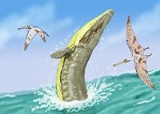
Valanginian
Encyclopedia
In the geologic timescale, the Valanginian is an age or stage of the Early or Lower Cretaceous
. It spans between 140.2 ± 3.0 Ma and 136.4 ± 2.0 Ma (million years ago). The Valanginian stage succeeds the Berriasian
stage of the Lower Cretaceous and precedes the Hauterivian
stage of the Lower Cretaceous.
, a small town north of Neuchâtel in the Jura Mountains
of Switzerland
.
The base of the Valanginian is at the first appearance of calpionellid species Calpionellites darderi in the stratigraphic column. A global reference section (a GSSP) had in 2009 not yet been appointed.
The top of the Valanginian (the base of the Hauterivian) is at the first appearance of the ammonite
genus
Acanthodiscus
.
In the Tethys domain
, the Valanginian stage contains five ammonite biozone
s:
Early Cretaceous
The Early Cretaceous or the Lower Cretaceous , is the earlier or lower of the two major divisions of the Cretaceous...
. It spans between 140.2 ± 3.0 Ma and 136.4 ± 2.0 Ma (million years ago). The Valanginian stage succeeds the Berriasian
Berriasian
In the geological timescale, the Berriasian is an age or stage of the Early or Lower Creteceous. It is the oldest or lowest subdivision in the entire Cretaceous. It spanned between 145.5 ± 4.0 Ma and 140.2 ± 3.0 Ma...
stage of the Lower Cretaceous and precedes the Hauterivian
Hauterivian
The Hauterivian is, in the geologic timescale, an age in the Early Cretaceous epoch or a stage in the Lower Cretaceous series. It spans the time between 136.4 ± 2 Ma and 130 ± 1.5 Ma...
stage of the Lower Cretaceous.
Stratigraphic definitions
The Valanginian was first described and named by Édouard Desor in 1853. It is named after ValanginValangin
Valangin is a municipality in the district of Val-de-Ruz in the canton of Neuchâtel in Switzerland.-Geography:Valangin has an area, , of . Of this area, or 39.4% is used for agricultural purposes, while or 49.7% is forested...
, a small town north of Neuchâtel in the Jura Mountains
Jura mountains
The Jura Mountains are a small mountain range located north of the Alps, separating the Rhine and Rhone rivers and forming part of the watershed of each...
of Switzerland
Switzerland
Switzerland name of one of the Swiss cantons. ; ; ; or ), in its full name the Swiss Confederation , is a federal republic consisting of 26 cantons, with Bern as the seat of the federal authorities. The country is situated in Western Europe,Or Central Europe depending on the definition....
.
The base of the Valanginian is at the first appearance of calpionellid species Calpionellites darderi in the stratigraphic column. A global reference section (a GSSP) had in 2009 not yet been appointed.
The top of the Valanginian (the base of the Hauterivian) is at the first appearance of the ammonite
Ammonite
Ammonite, as a zoological or paleontological term, refers to any member of the Ammonoidea an extinct subclass within the Molluscan class Cephalopoda which are more closely related to living coleoids Ammonite, as a zoological or paleontological term, refers to any member of the Ammonoidea an extinct...
genus
Genus
In biology, a genus is a low-level taxonomic rank used in the biological classification of living and fossil organisms, which is an example of definition by genus and differentia...
Acanthodiscus
Acanthodiscus
Acanthodiscus is an extinct ammonoid cephalopod genus from the order Ammonitida and included in the persphinctacean family Berriasellidae. The type, named by Bruguière ,1779, is Acanthodiscus radiatus.-Description:...
.
Subdivision
The Valanginian is often subdivided in Lower and Upper substages. The Upper substage begins at the first appearance of ammonite species Saynoceras verrucosum and the major marine transgression Va3.In the Tethys domain
Tethys Ocean
The Tethys Ocean was an ocean that existed between the continents of Gondwana and Laurasia during the Mesozoic era before the opening of the Indian Ocean.-Modern theory:...
, the Valanginian stage contains five ammonite biozone
Biozone
Biostratigraphic units or Biozones are intervals of geological strata that are defined on the basis of their characteristic fossil taxa....
s:
- zone of Criosarasinella furcillata
- zone of Neocomites peregrinus
- zone of Saynoceras verrucosum
- zone of Busnardoites campylotoxus
- zone of Tirnovella pertransiens
†Ankylosaurs
| Ankylosauria Ankylosauria Ankylosauria is a group of herbivorous dinosaurs of the order Ornithischia. It includes the great majority of dinosaurs with armor in the form of bony osteoderms. Ankylosaurs were bulky quadrupeds, with short, powerful limbs. They are first known to have appeared in the early Jurassic Period of... of the Valanginian |
||||
|---|---|---|---|---|
| Taxa | Presence | Location | Description | Images |
|
 |
|||
Birds
| Birds of the Valanginian | ||||
|---|---|---|---|---|
| Taxa | Presence | Location | Description | Images |
|
Wyleyia Wyleyia is a prehistoric bird genus with a single species, Wyleyia valdensis, known from the Early Cretaceous of England. Even this is only known from a single damaged right humerus. It has been named to honor J. F. Wyley, who found the specimen in the Weald Clay deposits of Henfield in Sussex... |
||||
Crocodylomorphs
| Crocodylomorphs of the Valanginian | ||||
|---|---|---|---|---|
| Taxa | Presence | Location | Description | Images |
|
 |
|||
|
||||
|
Machimosaurus Machimosaurus is an extinct genus of teleosaurid crocodyliform from the Late Jurassic and Early Cretaceous . The type species, Machimosaurus hugii, was found in France. Other fossils have been found in Austria, England, Germany, Portugal and Switzerland... |
||||
†Ornithopods
| Ornithopoda of the Valanginian | ||||
|---|---|---|---|---|
| Taxa | Presence | Location | Description | Images |
|
Australia | May be a chimera Chimera (paleontology) In paleontology, a chimera is a fossil which was reconstructed with elements coming from more than a single species of animal. A now classic example of chimera is Protoavis.-List of paleontological chimeras:*Brontosaurus*Lametasaurus... based on multiple species of ornithopods. |
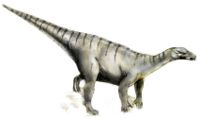  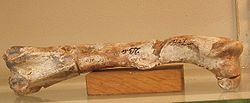 |
|
|
Europe, North America | |||
|
Kangnasaurus Kangnasaurus is a genus of iguanodontian ornithopod dinosaur found in supposedly Early Cretaceous rocks of South Africa. It is known from a tooth and possibly some postcranial remains. At times, it has been considered dubious or a valid genus... |
Cape Province, South Africa | Generally considered nomen dubium, it classified as a genus similar to Dryosaurus, i.e. an iguanodont. | ||
|
Lanzhousaurus Lanzhousaurus is a genus of dinosaur. Lanzhousaurus lived in the Gansu region of what is now China during the Early Cretaceous. A partial skeleton has been recovered... |
Lanzhou Lanzhou Lanzhou is the capital and largest city of Gansu Province in Northwest China. A prefecture-level city, it is a key regional transportation hub, allowing areas further west to maintain railroad connections to the eastern half of the country.... , Gansu, China |
Notable for its "astonishingly huge teeth", among the largest for any herbivorous creature ever, which indicate it is an iguanodont. The mandible, longer than one meter, suggests very large size for the animal. | ||
|
Valdosaurus Valdosaurus is a genus of bipedal herbivorous iguanodont ornithopod dinosaur found on the Isle of Wight and elsewhere in England. It lived during the Early Cretaceous.-Discovery and naming:... |
Isle of Wight, England; Niger, Africa | A dryosaurid | ||
†Pterosaurs
| Pterosaurs of the Valanginian | ||||
|---|---|---|---|---|
| Taxa | Presence | Location | Description | Images |
|
 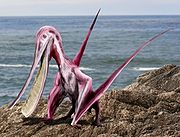 |
|||
|
Lagarcito Formation, San Luis Province, Argentina; Chile | |||
†Sauropods
| Sauropods Sauropoda Sauropoda , or the sauropods , are an infraorder of saurischian dinosaurs. They had long necks, long tails, small heads , and thick, pillar-like legs. They are notable for the enormous sizes attained by some species, and the group includes the largest animals to have ever lived on land... of the Valanginian |
||||
|---|---|---|---|---|
| Taxa | Presence | Location | Description | Images |
|
||||
|
Xenoposeidon Xenoposeidon is a genus of sauropod dinosaur from the Early Cretaceous of England, living about 140 million years ago. It is known from a single partial vertebra with unusual features, unlike those of other sauropods... |
||||
†Stegosaurs
| Stegosaurs of the Valanginian | ||||
|---|---|---|---|---|
| Taxa | Presence | Location | Description | Images |
|
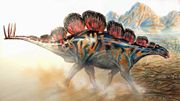 |
|||
|
||||
|
Wuerhosaurus Wuerhosaurus is a genus of stegosaurid dinosaur from the Early Cretaceous Period of China. As such, it was one of the last genera of stegosaurians known to have existed, since most others lived in the late Jurassic.-Discovery and species:... |
||||
†Theropods (non-avian)
| Non-Avian Theropods of the Valanginian | ||||
|---|---|---|---|---|
| Taxa | Presence | Location | Description | Images |
|
||||
|
Nqwebasaurus Nqwebasaurus is the name given to a genus of dinosaur from the Tithonian to Valanginian . It was a basal coelurosaur related to Ornitholestes. Its fossils were found in South Africa in the Kirkwood Formation, which is called Nqweba in the native language of the Xhosa... |
||||
|
Phaedrolosaurus Phaedrolosaurus was a genus of theropod dinosaur, based on a single tooth possibly from the Valanginian-Albian-age Lower Cretaceous Lianmugin Formation of Wuerho, Xinjiang, China. This tooth, IVPP V 4024-1, was described by Dong Zhiming as like those of Deinonychus, albeit thicker, shorter, and... |
||||
|
Xinjiangovenator Xinjiangovenator is a genus of coelurosaurian dinosaur of the Valanginian to Albian stages of the Early Cretaceous period. Its remains were found in the Lianmuqin Formation of Wuerho, Xinjiang, China, and were first described by Dong Zhiming... |
||||
External links
- GeoWhen Database - Valanginian
- Mid-Cretaceous timescale and ühttp://stratigraphy.science.purdue.edu/charts/Timeslices/5_JurCret.pdf Jurassic-Cretaceous timescale], at the website of the subcommission for stratigraphic information of the ICS
- Stratigraphic chart of the Lower Cretaceous, at the website of Norges Network of offshore records of geology and stratigraphy

